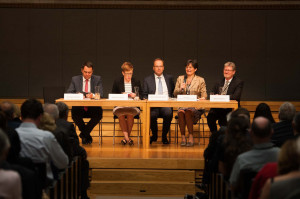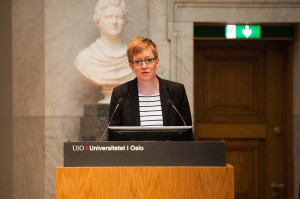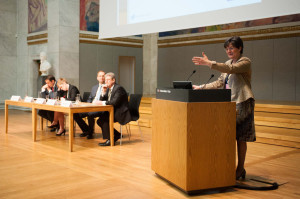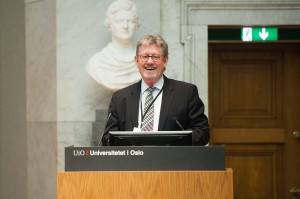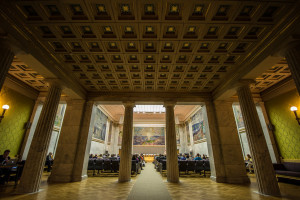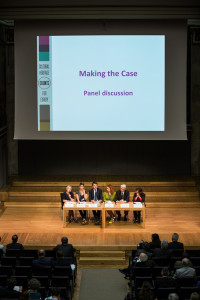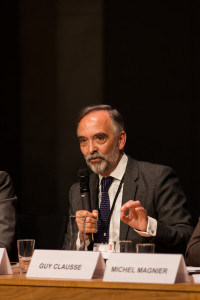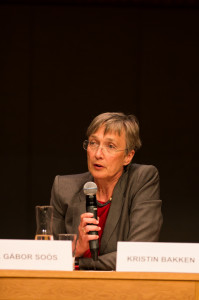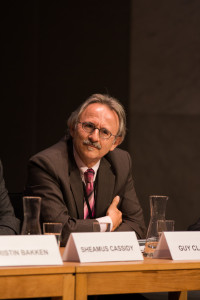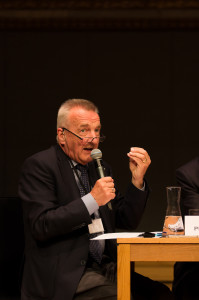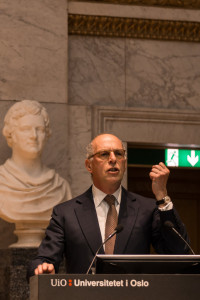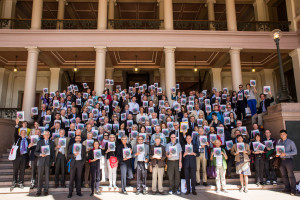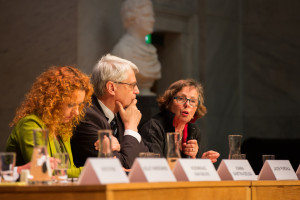 As an invited speaker at the Cultural Heritage Counts for Europe’s concluding conference held on 12 June 15 in Oslo, Norway, Prof. Claire Giraud-Labalte, member of the CHCFE Steering and chair of the ENCATC Thematic Area “Understanding Heritage” shared her reactions to the CHCFE process of mapping and analysing existing evidence of the impact of cultural heritage in Europe over the course of two years and resulting in the CHCFE final publication and recommendations.
As an invited speaker at the Cultural Heritage Counts for Europe’s concluding conference held on 12 June 15 in Oslo, Norway, Prof. Claire Giraud-Labalte, member of the CHCFE Steering and chair of the ENCATC Thematic Area “Understanding Heritage” shared her reactions to the CHCFE process of mapping and analysing existing evidence of the impact of cultural heritage in Europe over the course of two years and resulting in the CHCFE final publication and recommendations.
Speaking in between the conference’s two panel discussions “Making the Case”, which was intended to give an overview of the CHCFE study and its results, and the second “What implications for evidence-based policy making in Europe?” to open perspectives and future implications for European cultural heritage policy.
What can we take away from this shared experience over these last 2 years? What reflections from this collective project can inspire us? In the brief time allotted to us, I would will do some basic, yet essential reminders and focus on a few points.
1. The Process is as valuable as the research result
To illustrate my point, let me use a metaphor : Here we are crossing a river on a bridge connecting two banks in a landscape which represents cultural heritage and its complex context.
Whether we are venturing into the unknown or into very familiar territory, it is necessary to agree before starting any project: What is the situation? What is the problem? Who are we? What do we want to observe? With what means? What assets and what constraints?
The topic invites reflection, and subsequently we transform our ideas through research into a built, developed and problematized purpose. This process causes also a changing relationship with the initial question. This means keeping an open mind and not letting oneself be locked into the first working assumptions.
Watching, analyzing “our landscape” requires care to maintain an adequate distance from the subject, not too far, but not too close either. This critical distance, which is constitutive for any researcher, is particularly important to respect in the cultural area that is often synonymous with passion and involvement. Indeed everyone, as a human being, already has a point of view, and prejudices suggesting that our vision is clear, even “natural”. Of course, this is not the reality.
In the case of CHCfE, which was to map and to bring forth inspiring recommendations, a time to take distance is also needed before moving from one river bank to the other, I mean between the phase of collecting and synthesizing data and the time for action which will exploit these results.
In the end, an overview on the project in needed as well on the process, including some collected feed-backs.
2. Diversity and Disparities to be considered
First, the research reflects the diversity of European heritage and can been found in the examples recorded.
This diversity also characterizes the Consortium of the “Cultural Heritage Counts for Europe” project and the steering committee that included researchers – juniors and seniors – from various disciplines, responsible for heritage structures or networks, of different nationalities and cultures. Integrated in the process of reflection, this diversity of approach is an add value if given the time required for exchange and maturation of Intercultural dialogue.
The project also shows some differences between East and West as Prof. Purchla mentioned just some minutes ago. This reality was made evident by having two research teams, one from Poland and one from Belgium.
If we shuffle the cards and change our focus, other differences of various kinds as well as disparities would have a chance to emerge, especially in such an international project. Indeed, any heritage research carries with it its own culture, in a given time and a given space. Is this culture internalized? Does a group come to a consensus on heritage? What interpretation is proposed and in what frame of reference? Realities are often different behind even a common vocabulary (heritage, identity, interpretation, holistic approach, governance, participatory process, evaluation, etc.) ; this calls for clarification and an explanation of the concepts used.
Part of the complexity, this polymorphic diversity is thus an asset if we consider it. It would be damaging to European heritage and for policies to be implemented, if it was ignored.
3. From Research to action: promoting a collaborative approach
The findings of the study have inspired for us a range of Recommendations. I think everyone here can see how at least one or more of these recommendations can contribute to their activities and priorities.
For example, as an academic and researcher in a nearby field, member of Encatc – a network for cultural management and policy education – I would like to focus on research and training in the cultural and heritage sector which represents a challenge for Europe.
I wish to speak in favor of applied research development based on a balance between scientific rigor and social utility for the overall well-being of society. In other words, the challenge is to oppose both the radicalism of academic research, sometimes divorced from reality, and the exploitation of research, for political ends.
The objective is to provide policy makers with the analysis of a situation and how to inform their decisions & choices.
Once this option is taken, it should support cooperation between researchers and actors of heritage sector.
We have to join forces. While respecting the specificities and ethics [Aissic] of each, this is to enrich the knowledge of a territory or a problem using with reciprocal exchanges and dialogue.
This means : to inform, to train, to develop a cross-disciplinary approach & a participatory way :
- to inform stakeholders (politicians, policy makers, opinion formers, researchers, managers from private or public organizations, civil society, etc.) from the heritage sector and neighboring sectors (culture, environment…) about EU News Culture (communication 2014, statements of Namur)
- to widely disseminate the studies in understandable terms for a non-specialist audience
- to widely disseminate relevant research programs on current and emerging issues
- to enhance training of cross-disciplinary research and / or international groups (building, comparing, evaluating concepts, methods, models, indicators, results)
- to enhance Life Long Learning in the Heritage sector according to the principles outlined here
- to promote articulation between territorial levels (regional, national, European) through information, education, and training of all stakeholders
- to develop cross-disciplinary exchanges between researchers and stakeholders using an holistic approach and in a participatory way
Such experiments conducted in several regions (for example, Regional Consultative Conference on Culture (CRCC) Pays de la Loire, France) are conclusive. They nourish an iterative movement that encourages a more participatory governance in favor of our cultural heritage “that counts for Europe”.
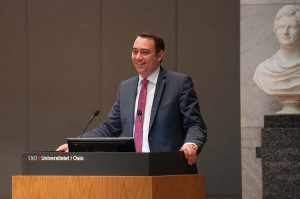
Maxime Prévot, Vice-President and Minister of Wallonia’s Government, Chairman of the 6th Council of Europe Ministerial Conference for Heritage
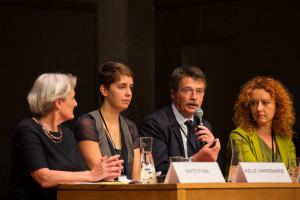
Panel I. Making the Case with Kate Pugh, CEO, The Heritage Alliance (England, UK); Aziliz Vandesande, Phd Researcher, Raymond Lemaire International Centre for Conservation, University of Leuven (Belgium); Prof. Koenraad Van Balen, Director of the Raymond Lemaire International Centre for Conservation, University of Leuven (Belgium); and Joanna Sanetra-Szeliga, Researcher at the Institute for European Heritage, International Cultural Centre in Krakow (Poland)
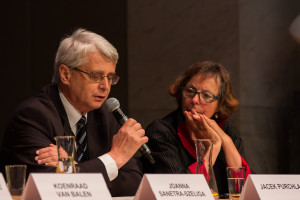
Panel I. Making the Case with Prof. Jacek Purchla, Director of the International Cultural Centre in Krakow (Poland) and Prof. Claire Giraud-Labalte, Chair of the ENCATC Thematic Area Understanding Heritage and ENCATC Ambassador, Nantes (France)

Panel I. Making the Case with Joanna Sanetra-Szeliga, Research Institute for European Heritage, International Cultural Centre in Krakow (Poland); Prof. Jacek Purchla, Director of the International Cultural Centre in Krakow (Poland); and Prof. Claire Giraud-Labalte, Chair of the ENCATC Thematic Area Understanding Heritage and ENCATC Ambassador, Nantes (France)
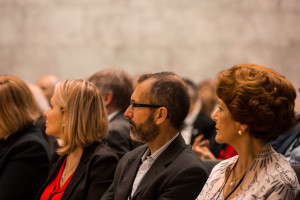
Androulla Vassiliou, former European Commissioner for Education, Culture, Multilingualism and Youth (right), Michel Magnier, Director for Culture and Creativity, Directorate General for Education and Culture, European Commission (centre), Adrienn Kiraly, Deputy Head of Cabinet of Commissioner Navracsics (left)
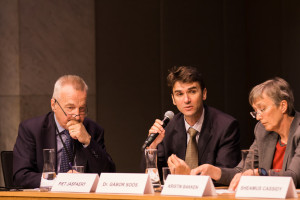
Panel II. with Piet Jaspaert, Board Member, Europa Nostra; Gábor Soós, Head of Division, Division of World Heritage, Gyula Forster National Centre for Cultural Heritage Management, Budapest (Hungary); and Dr. Art. Kristin Bakken, Deputy Director, Directorate for Cultural Heritage in Norway
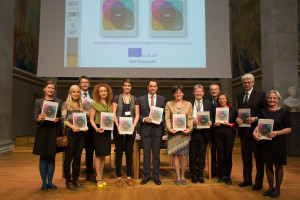
Members of the CHCFE consortium with Maxime Prévot, Vice-President and Minister of Wallonia’s Government, Chairman of the 6th Council of Europe Ministerial Conference for Heritage
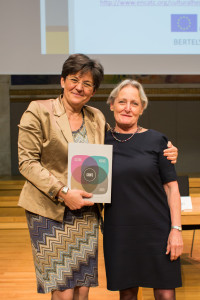
Sneška Quaedvlieg-Mihailović, Secretary General of Europa Nostra and Kate Pugh, CEO, The Heritage Alliance (England, UK)
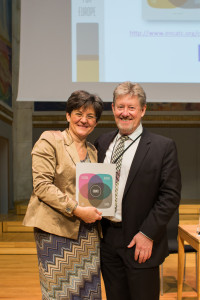
Sneška Quaedvlieg-Mihailović, Secretary General of Europa Nostra and Brian Smith, Secretary General of Heritage Europe
All photos by Felix Quaedvlieg originally published on Flickr / CC BY-NC-SA 2.0
Cultural Heritage Counts for Europe Concluding Conference
12 June 2015 at the University of Oslo in Norway
Address by Maxime Prévot, Vice-President and Minister of Wallonia’s Government, Chairman of the 6th Council of Europe Ministerial Conference for Heritage to attendees during the opening session.
(Check against delivery)

Maxime Prévot, Vice-President and Minister of Wallonia’s Government, Chairman of the 6th Council of Europe Ministerial Conference for Heritage speaking at the Cultural Heritage Counts for Europe concluding conference.
Mister European Commissioner,
Madame State Secretary,
Mister President,
Madame General Secretary,
Ladies and gentlemen,
When Madame Sneska Quadvleig-Mihailovic spoke to intervene at the first work session of the 6th conference of the council of Europe of the Ministers of heritage that took place at Namur on the 23rd and the 24th of April, a wave of freshness and enthusiasm invaded the conference room. As a defendant of heritage she expressed several times in the name of civil society, which Europa Nostra, with other associations, represents on international level. I therefore have the pleasure to note that this conference, held in the context of the Belgian chairmanship of the Council of Europe, answered a real need, a shared expectation, by the States and their administrations as well as the professionals, the intergovernmental and non-governmental organisations. If I am here today it’s because it seems evident, to the multiple actors of heritage that we had to move to a higher stage of their reflection according to politics of the management of heritage. It’s not enough to talk about new tools for the past but we have to put those new tools into a real strategy for heritage. A couple months’ ago, a group of experts, such as Europa Nostra, got together under the auspices of Wallonia, the French speaking region of Belgium, in which I am Vice-President and Minister of Heritage, to identify the most pertinent way to respond to the need in which the framework was not clear yet. Playing a major part, the Walloon administration, in perfect cooperation with the administrations of other regions in Belgium and the Council of Europe, particularly through the network of Herein, progressively traced the priority axes that should be a strong strategy for heritage in Europe.
Indeed, the Conference of Namur had the principal objective, to make the contracting state parties of the European cultural convention agree on the necessity to identify the key objectives of this strategy. The world and Europe have changed over the last few years and this realisation operates on a climatic as well as a demographic level. These changes are accompanied by a number of political, social and economic crisis’s which have a tendency to weaken our societies. In the seventies, heritage came to the front of the stage after the destruction during the two wars and campaigns, sometimes even destructive for heritage, and as we reconstruct, we recognize progressively its importance as a structured element of our identity. The perception of the role of heritage then evolved, going from a set of objects of great value to protect to the realization that cultural heritage is a unique source, fragile, non-renewable and non-relocatable, contributing to the attractiveness and development of the territories and the wellbeing of the population. The framework-convention of Faro put humanity back in the heart of heritage, making it come down from its pedestal and finally permitting a real appropriation, for mankind, of his built and natural environment. The strategy, in which the construction has been confided in the European States at the Council of Europe, registers in the straight line of this evolution, and wishes a concrete, operational, concerted and shared application of the texts and tools that are based on cultural heritage.
I’m not going to resume here the Declaration of Namur but we have to recognize that the results of the study that are the objects of the presentation and debates to follow, confirm and complete the work from less than a month ago. I’m happy to see that the preoccupations of the European Union join those of the Council of Europe. The 4 axes around which the strategy of heritage will articulate are confirmed by the principal conclusions of the study and, without revealing what will be presented to you, I’m happy to know that by identifying the priority axes in Namur we saw:
- First, the contribution of heritage as a big issue for the improvement of the frame and quality of life of European citizens,
- Secondly the contribution of heritage as a way for enhancing the attractiveness and prosperity of Europe, based on the expression of its identities and its cultural diversities.
- We also stressed the importance of education and training for a lifetime,
- And finally the particular governance in the domain of heritage.
At the last Director Committee Culture, Heritage, Landscape (CDCPP) of the Council of Europe, the different states confirmed the mission that has been confided to them: the countries of the Council of Europe have to develop, by the end of 2016, a coherent and integrated dispositive that will allow respect of the differences of perception of Heritage and certain problems faced by different States and actors. About that, the project Cultural Heritage Counts for Europe is a remarkable example of what could be an inclusive management of Heritage in association with experts, associations, international institutions and administrations.
Before concluding my speech, I’d like to put the light on two specific issues witch concern all the public authorities, from the local one to the European community :
- First, Heritage and Citizenship: one of my battle horses is to improve the efficiency of participatory management dispositive of cultural heritage. In this complex institutional complex, just like the one in Belgium, it’s indispensable to work on a clarification of the dispositive, so that we can improve the management of cultural heritage and that we can promote good governance and favour participative management.
- Secondly, Heritage and the Economy: which are clearly the heart of this Congress and for my part, I have to face some serious budgetary restrictions. This imposes to prove our creativity for the perception of heritage as well as for the funding of its needs. As non-locatable resources, heritage is a potential source of employment and wealth but its use has to be well framed so that we can avoid that adverse mechanisms like social dumping to have an opposite effect on the one looked for. Nevertheless, it seems that heritage can generate a larger public then the limited circle of insiders and could be a source of wealth.
The project Cultural Heritage counts for Europe constitutes, from my point of view, a remarkable opportunity that could be integrated management of heritage.
I’ll conclude this intervention by thanking again Europa Nostra, its president, and its general secretary, Madame Quadvleig-Mihailovic, for their invitation to this congress. It’s an opportunity to insist even more on the necessity to place cultural heritage at the centre of the preoccupations of the states and the citizens and to recall that its protection is not a luxury but a duty that strongly reminds us of the voluntary destruction we witness still today and that the Call of Namur needs to be denounced with force.
So, as we said yesterday all together: We need to be UNITED FOR HERITAGE
Cultural Heritage Counts for Europe Concluding Conference
12 June 2015 at the University of Oslo in Norway
Address by Ingvild Stub, State Secretary, Norwegian Ministry of Foreign Affairs to attendees during the opening session.
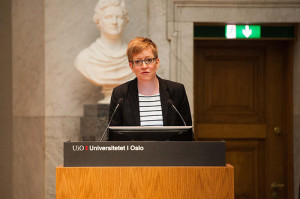
Ingvild Stub, State Secretary, Norwegian Ministry of Foreign Affairs, speaking at the Cultural Heritage Counts for Europe concluding conference in Oslo on 12 June 2015.
Commissioner Navracsics,
Minister Prévot,
Ladies and gentlemen,
It is a pleasure to welcome you to Oslo on behalf of the Norwegian Government, and to welcome you to this conference where Europa Nostra and its partners present the results of intensive European Union funded cooperation. In my view the report (Cultural Counts for Europe) is an important building block for enhanced policy on and developing cultural heritage management across Europe. I’d like to thank you for choosing Norway as the venue for this important event.
How very fitting it is, that this milestone report is presented here in the Aula of the recently restored Domus Media, with its long history, firmly rooted in Norway’s heritage. As you have no doubt noticed, you are surrounded by eleven paintings by Edvard Munch. These are an important part of our cultural heritage. They are intended – as the artist put it himself – ‘to form a complete, independent world of ideas’. Munch wanted them to be distinctively Norwegian and universally human. I’m sure you will agree that he succeeded in this. These works were finished as the First World War was raging across Europe. Against this backdrop it is interesting to note that Munch chose to convey a brighter view of history and humanity, and to use the rays of the sun to symbolise the hope of human enlightenment.
Norway and the European Union
Norway is not member of the EU, but we are very much a part of Europe through our participation in the European Economic Area, or the EEA. We also contribute to reducing social and economic disparities through the EEA and Norway Grants, which are used to fund programmes and projects in sixteen EU Member States.
EEA and Norway Grants
Culture is one of our priority sectors. We fund cultural heritage and cultural cooperation activities in fourteen countries, with a total budget of €204 million Euros for a period of five years. We aim for sustainability by stimulating capacity development and awareness raising in restoration, conservation, and reuse of cultural heritage, and through meaningful bilateral partnerships that pave the way for future cooperation. When it comes to cultural heritage, I do not want to mince my words: in my view cultural heritage is not about ‘a crumbling ancient past’.
- It is about ‘a fresh and realistic present’,
- it is about ‘managing heritage in order to grasp opportunities’,
- it is about ‘innovative and locally anchored ways to merge the past with the future’.
Views on the Report
I am pleased to see that the report looks at the effects that investments in this sector have on local development, employment, skills development, social inclusion and mutual understanding, as well as on maximising impact. These are aims shared by Norway. We also share the report’s view that strategic cultural heritage management is required at all levels of government. This is already embedded in Norway’s approach to cultural heritage, which includes the goal that all Norway’s municipalities will have drawn up plans for the conservation of their monuments and other cultural heritage sites by 2020. And through the EEA and Norway Grants, we support projects that conserve local cultural heritage, increase local people’s skills, and improve services for cultural tourism.
Most importantly, as the report stresses, a holistic and integrated approach is essential for the best possible management of cultural heritage. This was the approach taken when shaping the current funding period of the EEA and Norway Grants. While this strategic aim proved challenging to implement in some cases, an integrated approach has produced good results in others.
We support a range of efforts, from large-scale awareness-raising projects to smaller projects aimed at building mutual understanding between different communities with focus on their shared heritage. Let me give you some examples:
- Our support to the Museum of the History of Polish Jews in Warsaw raises awareness of minority issues and promotes understanding and tolerance.
- The development of the new Centre for Visual Arts and Research close to the buffer zone in Nicosia has enhanced dialogue between the Turk-Cypriot and the Greek-Cypriot communities.
- 45 % of the current projects are being carried out in cooperation with partners from Iceland, Liechtenstein and/or Norway, which increases the capacity of the beneficiary and the donor countries to work internationally.
- The restoration of the historical Rezekne Green Synagogue in Latvia is bringing together pupils from Norway and Latvia. The project merges these nations’ expertise in the care of Latvia’s wooden buildings, and is paving the way for meaningful bilateral cooperation for the future. It also increases young people’s skills and thus helps to bridge the gap between school and work.
- We are very pleased that the excellent quality of some of our projects have been recognised by the European Prize for Cultural Heritage, the Europa Nostra Awards.
- Last year, the Atjaro (Passage) Project in Hungary won the Grand Prix 2014; and the Home for Cooperation project in Cyprus and the Route of Torres Vedras in Portugal won the Conservation category in 2014.
We are currently looking at how our cultural heritage and cultural cooperation programmes are progressing. While good progress is being made, we note that the focus in several projects is mainly on restoration and conservation. These projects do not always take into account the broader management aspects related to heritage’s surroundings and its instrumental value. We will put more emphasis on this aspect in future programmes.
Concluding remarks
The report presented here today provides building blocks for increasing the impact of cultural heritage policy. There are significant opportunities if we use our heritage resources strategically. Returning to Edvard Munch and the bright outlook of these paintings, we should remember that the development of cultural heritage can play an important part in meeting the current challenges in Europe today – helping to create growth and job opportunities. I can assure you that Norway will take careful note of the report, and will take the outcome of the discussions here today into account in future policy.
Thank you for your attention!
This speech was originally published here.
Cultural Heritage Counts for Europe Concluding Conference
12 June 2015 at the University of Oslo in Norway
Address by Tibor Navracsics, European Commissioner for Education, Culture, Youth and Sport to attendees during the opening session.
(Check against delivery)
Ladies and gentlemen,
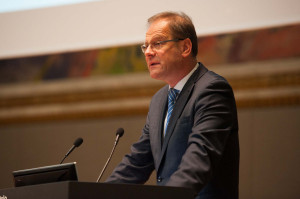
Tibor Navracsics, European Commissioner for Education, Culture, Youth and Sport speaking at the Cultural Heritage Counts for Europe concluding conference in Oslo on 12 June 2015.
Yesterday, at the Oslo City Hall, I took part in the celebration of the European Union Prize for Cultural Heritage/Europa Nostra Award for the first time. It was inspiring. We paid tribute to the many experts and volunteers who safeguard the values embodied in our cultural heritage so that it can be passed on to future generations.
Today, in this magnificent aula, surrounded by Edward Munch’s masterpieces, we will reflect more on those very values. We will look at the benefits that the project “Cultural Heritage Counts for Europe” has identified. Benefits for European culture, the environment, the economy and for society as a whole.
For all of us here, there is no doubt that heritage matters. It is the soul of our cities and the source of our identity. But we all know too well that many people are indifferent to cultural heritage, or simply not aware of its value.
This is a real problem. We are so used to what surrounds us – the historic environment, the archaeological sites – that we may forget that heritage needs a lot of care to survive.
It is sad, but we seem to appreciate its value most when it is under threat. This is the case today, not so far from here. Like you, I am appalled when I see the terrible destruction of heritage in countries like Iraq and Syria. These are unacceptable attacks on the culture of those countries and on the people who live there. But let me be clear: These crimes are also attacks on our shared values as human beings, wherever we happen to live.
Then there are other, less violent threats to heritage. Wherever investment in cultural and heritage policies is reduced, heritage is in danger. Unfortunately, because of the economic crisis, we see this happen a lot. We need swift action – and an evidence-based approach to cultural policy-making.
A wealth of studies highlights the significant contribution of the heritage sector to economic and social development. We know that cultural heritage can boost other economic sectors. Tourism, for instance, is estimated to contribute EUR 415 billion to the EU’s Gross domestic product. 3.4 million tourism enterprises account for 15.2 million jobs – many are linked to heritage, directly or indirectly.
But these are only partial estimates. EU-wide comparable data are still lacking. And in modern policy-making, a lack of data is fatal. As cultural operators know, when it comes to convincing decision makers to invest in culture, even the most compelling data may not be a guarantee of success. However, without any data, you are bound to fail from the start.
This is what makes “Cultural Heritage Counts for Europe” so important. I would like to thank the consortium for helping to fill this gap. Your project provides a much-awaited mapping of the research carried out at the European, national, regional and sectoral levels. You are helping to build the case for heritage in a solid and rigorous manner.
Now we can prove that the regeneration of urban sites attracts investment and creates jobs. Look at what happened at the Zsnolnay Cultural Quarter in Pecs or the Temple Bar in Dublin. And the high returns of investing in heritage are certified by a study by the World Bank.
All available evidence confirms that heritage is a strategic resource for a sustainable Europe. EU Member States clearly and explicitly recognised this last year.
But this is not enough. We need to enhance our policy action at all levels, including the European one.
This was the European Commission’s intention last year, when we published our strategy “Towards an integrated approach to heritage policies”. We proposed a way forward for enriching the value of cultural heritage further. This vision, which owes a lot to my predecessor Androulla Vassiliou’s commitment, has been fully endorsed by the new Commission. It will be our roadmap for the next five years.
New funding opportunities are supporting this approach, with programmes such as Creative Europe, Horizon2020, Erasmus+ and our structural funds.
And with actions like the European Capitals of Culture, the European Heritage Label, the European Heritage Days – and of course the European Heritage Awards – we are stimulating the whole cycle of cultural production and preservation. We are promoting high standards and high-quality skills in conservation practice. We are engaging Europe’s citizens in a deeper reflection on the roots and the meaning of European identity.
The main challenge now is to take advantage of these opportunities. It is time to develop a truly integrated approach to heritage, maximising the impact of heritage policies on the local economy and society. This is one of my priorities.
We have just started work with Member States on improving the governance of heritage policies. Good governance can contribute to a virtuous cycle of economic growth and social progress. But for this, public and private actors, local communities and stakeholders must all be active in managing and maintaining heritage.
We are identifying innovative models for participatory governance for cultural heritage. There is a wealth of good practices across the EU from which we can learn. I am confident that this work will be extremely useful.
Ladies and Gentlemen,
When Edward Munch decorated this aula, he wanted to create an artwork which was both distinctively Norwegian and universally human. The Alma Mater who nurtures her children with knowledge and the old man recounting his memories to a fascinated little boy remind us that it is not enough for the monuments of the past to be standing if their meaning is lost.
The knowledge embodied in those monuments must be preserved as well. It must be transmitted to the next generations. This is a task for every single one of us. Thanks to this project, we are one step closer to achieving it.
Thank you.
This speech was originally published on the European Commission’s website here.
T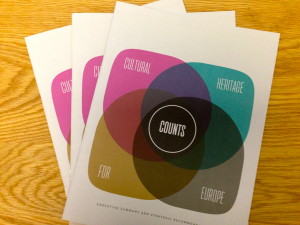 he partners of the EU-funded project ‘Cultural Heritage Counts for Europe’ (CHCFE) have published on 12 June the main findings and strategic recommendations for tapping into heritage’s full potential by providing compelling evidence of the value of cultural heritage and its impact on Europe’s economy, culture, society and the environment.
he partners of the EU-funded project ‘Cultural Heritage Counts for Europe’ (CHCFE) have published on 12 June the main findings and strategic recommendations for tapping into heritage’s full potential by providing compelling evidence of the value of cultural heritage and its impact on Europe’s economy, culture, society and the environment.
Key findings show how adopting a holistic approach is an added value when measuring the impact of cultural heritage on employment, identity, regional attractiveness, creativity and innovation, economic contribution, climate change, quality of life, education and lifelong learning, and social cohesion.
In the report’s Executive Summary and Strategic Recommendations, the CHCFE Steering Committee calls for the elaboration of specific “heritage indicators” to facilitate and improve the collection of cultural statistics which are key to support policy makers in evidence-based policy making; for the holistic impact assessment to be conducted as a requirement in all EU-funded heritage projects to better measure impact and monitor trends over a longer period of time. The Steering Committee also asks EU Institutions and its Member States at all levels of governance to integrate the care, protection and proper use of heritage in all related policies, programmes and actions and to include all stakeholders and civil society in developing strategies and policies for cultural heritage. Last but not least, it calls for the recognition of heritage’s positive contribution to regional and local sustainable development in the context of the mid-term review of the Structural Funds (in 2016-2017) and the preparation for the next generation of Structural Funds beyond 2020.
“All available evidence confirms that heritage is a strategic resource for a sustainable Europe. We need to enhance our policy action at all levels. It is time to develop a truly integrated approach to heritage, maximising the impact of heritage policies on the local economy and society. This is one of my priorities,” said Tibor Navracsics, European Commissioner for Education, Culture, Youth and Sport speaking at the launch of the CHCFE’s final report.
In addition to the key findings and strategic recommendations, the nearly 300-page report provides a snapshot in time of the currently available and accessible data within EU Members States on the wide-ranging impacts of cultural heritage in Europe. The report’s publication release builds on the momentum of policy makers recognizing the potential of Europe’s cultural heritage, most recently with the 6th Conference of Ministers responsible for Heritage organised under the Belgian Chairmanship of the Council of Europe (April 2015), but also the Horizon 2020 Expert Group on Cultural Heritage report Getting Cultural Heritage to Work (April 2015), the Conclusions on Participatory Governance of Cultural Heritage (November 2014) the Communication Towards on Integrated Approach to Cultural Heritage for Europe (July 2014), and the Conclusions on Cultural Heritage as a Strategic Resource for a Sustainable Europe (May 2014).
“The CHCfE consortium began this project to address the absence of readily accessible data on cultural heritage and of a comprehensive overview of its value and relevance on the European level which is so crucial for sound policy making. We are all pleased to see the enhanced interest which cultural heritage has generated at the EU and international level and truly hope that important body of work will contribute to strengthening the dialogue between civil society and decision makers with a view to realising the full potential of cultural heritage as a strategic resource for Europe’s future sustainable development,” states Sneška Quaedvlieg-Mihailović, Secretary General of Europa Nostra, on behalf of the CHCFE Steering Committee.
The project’s findings and final report were revealed at the CHCFE concluding conference held today at the University of Oslo and organised in conjunction with the Europa Nostra’s Annual Congress 2015. Keynote speakers included Tibor Navracsics, European Commissioner for Education, Culture, Youth and Sport, Ingvild Stub, State Secretary of the Norwegian Ministry of Foreign Affairs and Maxime Prévot, Vice-President and Minister of Wallonia’s Government. CHCFE project partners and heritage experts were also invited to present results and implications for evidence-based policy making in Europe to an audience of cultural heritage professionals, academics, researchers, and distinguished European political figures. A summary of the CHCFE concluding conference is forthcoming.
The full report and the executive summary are available for free download here.
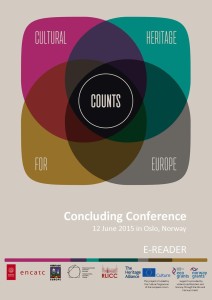 The reader for the Cultural Heritage Counts for Europe Concluding Conference is now available online! It includes a presentation of the project, programme, speaker biographies, project partner descriptions and venue information. Learn more about the 19 invited speakers who include distinguished European political figures, heritage experts, researchers and academics from Belgium, France, Hungary, Poland, and the United Kingdom.
The reader for the Cultural Heritage Counts for Europe Concluding Conference is now available online! It includes a presentation of the project, programme, speaker biographies, project partner descriptions and venue information. Learn more about the 19 invited speakers who include distinguished European political figures, heritage experts, researchers and academics from Belgium, France, Hungary, Poland, and the United Kingdom.
As this event is organised in the framework of the Europa Nostra 2015 Congress, registered participants will also be able to attend cultural visits to some of Oslo’s prestigious heritage sites and close the day with an evening networking cruise along the Oslo fjord on-board the Christian Radich, a three mast sailing ship built in 1937.
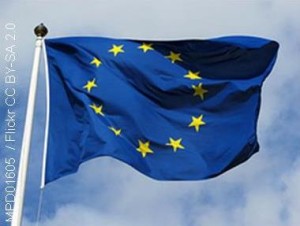 The concluding conference of Cultural Heritage Counts for Europe will be attended by distinguished European political figures, namely Tibor Navracsics, European Commissioner for Education, Culture, Youth and Sport, representing the European Union, which is the main supporter of the CHCFE project, and Ingvild Stub, State Secretary of the Norwegian Minister of Foreign Affairs, on behalf of the government of the host country, which has supported the CHCFE Conference in Oslo, and Maxime Prévot, Vice-President of Wallonia’s Government and Minister for Public Works, Health, Social Affairs and Heritage, who acted as the Chairman and Host of the 6th Conference of Ministers responsible for Heritage organised under the Belgian Chairmanship of the Council of Europe on 22-24 April 2015 in Namur. The Conference will be closed by an inspirational speech by Loyd Grossman, Chairman of The Heritage Alliance based in London which brings together nearly 100 independent heritage organisations from all over England.
The concluding conference of Cultural Heritage Counts for Europe will be attended by distinguished European political figures, namely Tibor Navracsics, European Commissioner for Education, Culture, Youth and Sport, representing the European Union, which is the main supporter of the CHCFE project, and Ingvild Stub, State Secretary of the Norwegian Minister of Foreign Affairs, on behalf of the government of the host country, which has supported the CHCFE Conference in Oslo, and Maxime Prévot, Vice-President of Wallonia’s Government and Minister for Public Works, Health, Social Affairs and Heritage, who acted as the Chairman and Host of the 6th Conference of Ministers responsible for Heritage organised under the Belgian Chairmanship of the Council of Europe on 22-24 April 2015 in Namur. The Conference will be closed by an inspirational speech by Loyd Grossman, Chairman of The Heritage Alliance based in London which brings together nearly 100 independent heritage organisations from all over England.
08.45 – 09.15 INTRODUCTION
Presentation of the Edvard Munch paintings decorating the Aula by Signe Endresen, PhD researcher on Edvard Munch
09.30 – 10.15 OPENING SESSION
Moderated by Sneška Quaedvlieg-Mihailović, Secretary General of Europa Nostra, on behalf of the CHCFE Steering Committee
Presentation of the key findings & recommendations of the CHCFE Project
Brian Smith, Secretary General of Heritage Europe, on behalf of the CHCFE Steering Committee
Addresses by
Tibor Navracsics, European Commissioner for Education, Culture, Youth and Sport
Ingvild Stub, State Secretary, Norwegian Ministry of Foreign Affairs
Maxime Prévot, Vice-President and Minister of Wallonia’s Government, Chairman of the 6th Council of Europe Ministerial Conference for Heritage
10.15 – 11.15 PANEL DISCUSSION: “Making the Case”
Moderated and introduced by Kate Pugh, CEO, The Heritage Alliance (England, UK)
Panelists
Prof. Jacek Purchla, Director of the International Cultural Centre in Krakow (Poland)
Joanna Sanetra-Szeliga, Research Institute for European Heritage, International Cultural Centre in Krakow (Poland)
Prof. Koenraad Van Balen, Director of the Raymond Lemaire International Centre for Conservation, University of Leuven (Belgium)
Aziliz Vandesande, Phd Researcher, Raymond Lemaire International Centre for Conservation, University of Leuven (Belgium)
Questions & Answers
Reaction by
Prof. Claire Giraud-Labalte, Chair of the ENCATC Thematic Area Understanding Heritage and ENCATC Ambassador, Nantes (France)
11.15 – 11.35 COFFEE BREAK
11.35 – 12.35 PANEL DISCUSSION: “What implications for evidence-based policy making in Europe?”
Moderated by Piet Jaspaert, Board Member, Europa Nostra
Panelists
Dr. Art. Kristin Bakken, Deputy Director, Directorate for Cultural Heritage in Norway
Guy Clausse, Dean, European Investment Bank Institute
Sheamus Cassidy, Senior Sector Officer for Cultural Heritage, EEA Funding Mechanism
Gábor Soós, Head of Division, Division of World Heritage, Gyula Forster National Centre for Cultural Heritage Management, Budapest (Hungary)
Questions & Answers
Reaction by
Michel Magnier, Director for Culture and Creativity, Directorate General for Education and Culture, European Commission
12.35-13.00 CLOSING SESSION
Introduced by John Sell, Executive Vice-President, Europa Nostra
Closing address by Dr Loyd Grossman, Chairman, The Heritage Alliance (England, UK)
The Concluding Conference in Oslo is organised with the financial support of the Culture Programme of the European Union:
Support is also provided by Iceland, Liechtenstein and Norway through the EEA and Norway Grants

